This week's NewsFlash sees celestial bulldozers, fossilised footprints and the first fish to ever have sex. Plus, we find out why unmanned planes could get more blood samples tested in rural Africa, and discover that this week in 1869 saw the proposal of the periodic table.
In this episode
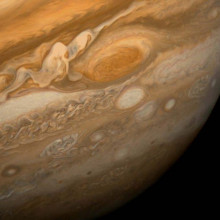
Missing Asteroid Mystery Mitigated
There are asteroids missing from the belt between Mars and Jupiter, and now researchers think they were shoved out of place by two of our solar system's gas giants - Jupiter and Saturn, as they assumed their current orbit some 4 billion years ago.
So the missing pieces of our asteroid belt can help us to fill in some of the missing pieces of the history of our solar system!
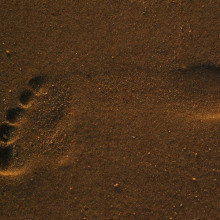
Walk like a man
As the Bee Gees sang in their seventies hit Staying Alive, there's a lot you can tell from the way someone uses their walk. And now it seems that our ancestors may have been walking like us for at least 1.5 million years.
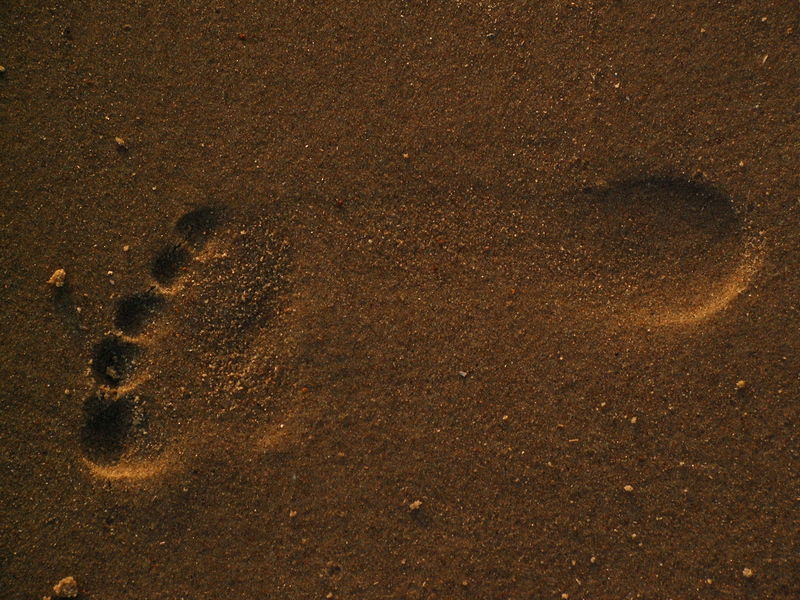 That's according to a study published this week in the journal Science by a team led by Matthew Bennett from Bournemouth University in the UK, who have uncovered two sets of fossilised footsteps thought to have been left behind by Homo erectus strolling through deposits of volcanic ash near Lake Turkana in northern Kenya between 1.53 and 1.51 million years ago.
That's according to a study published this week in the journal Science by a team led by Matthew Bennett from Bournemouth University in the UK, who have uncovered two sets of fossilised footsteps thought to have been left behind by Homo erectus strolling through deposits of volcanic ash near Lake Turkana in northern Kenya between 1.53 and 1.51 million years ago.
Walking on two feet is a key human adaptation that first evolved around 6 millions year ago, but until now there's not been enough evidence for when the modern human gait first evolved. Apparently there aren't many feet in the fossil record, possibly because predators and scavengers like to eat them.
The oldest known footprints from the human lineage are from Australopithecus afarensis 3.7 million years ago, but those footprints from Tanzania revealed that are ancestors at that stage were waking around with a more ape-like gait, with a splayed big toe and a foot generally suited for grasping things rather than walking along the ground.
These newly discovered tracks have a shape much more similar to what you leave behind when you walk along a beach. As we walk, we first put down our heal which makes a deep impression in the sand, then we move our weight to the ball of the foot - again making a deep impression - then we propel ourselves forward on our toes, and most importantly our big toe which lies in line with our feet.
It's incredible to think that just a few individual Homo erectus left their footprints in the mud which then turned to stone to be found a million and a half years later by their descendants and used to help unpick one of the great mysteries of human evolution.
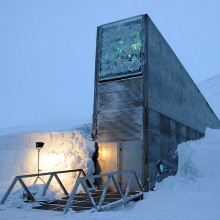
Happy Birthday Seeds!
A global seed bank in Svalbard celebrated its 1st birthday on the 26th of February, but rather than receiving a cake, they received a four tonne shipment of seeds from all over the world, bringing the total number of seeds stored to over 20 million.
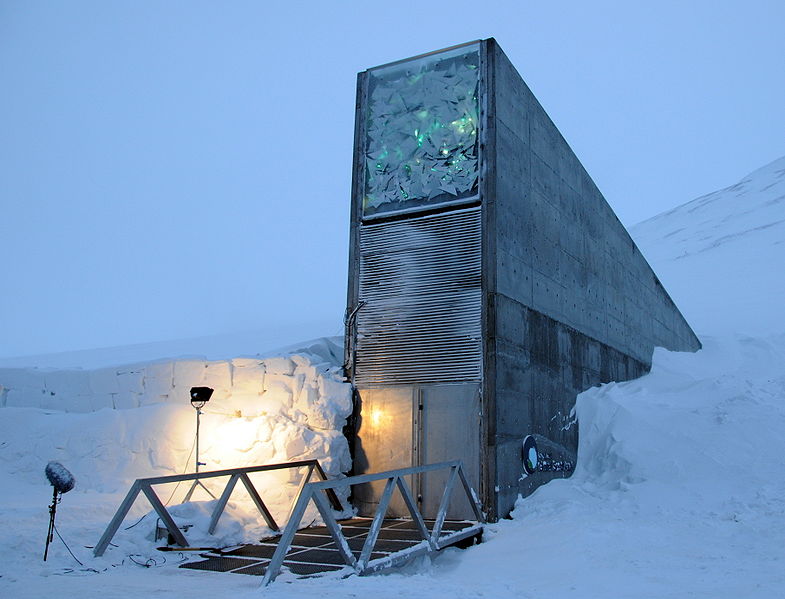 Described as the "custodians of the crown jewels of crop diversity", seed banks like this one are essential not only as an archive of wild and cultivated species, keeping them safe from whatever may happen in the wild, but also as an enormous genetic database that may enable us to grow more food crops or cope with a changing climate.
Described as the "custodians of the crown jewels of crop diversity", seed banks like this one are essential not only as an archive of wild and cultivated species, keeping them safe from whatever may happen in the wild, but also as an enormous genetic database that may enable us to grow more food crops or cope with a changing climate.
There have already been predictions that a changing climate could reduce maize production in Southern Africa by 30 percent over the next 20 years, which shows that we need to maintain as diverse a range of crops as possible in order to adapt our agriculture to the climate. Without these stored seeds and the genetic secrets they contain, we would struggle to maintain even the current level of food production.
Seeds arriving at the vault to celebrate its anniversary include 32 varieties of potatoes as well as oats, wheat, barley, and various wild grasses, and are travelling from Canada, Ireland, Switzerland, the USA, Syria, Mexico and Columbia, though many of the seeds they have amassed are from all over the world.
The Svalbard vault itself is an incredible feat of engineering, consisting of chambers carved 120 meters into a mountain, with a capacity to store 4.5 million types of seeds. It's part of a network of seed banks all over the world, each duplicating the seeds that the others hold as a back-up, so in the event of a global catastrophe, any one of them could act as a "Noah's Ark" for agriculture.
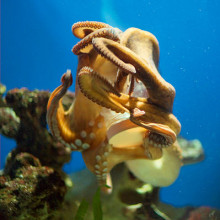
Wannabe octopus fugitive
It wasn't quite the Great Escape, but aquarium keepers at Santa Monica Pier Aquarium in the United States were left knee deep in water this week when a cheeky octopus tried to make a break for freedom.
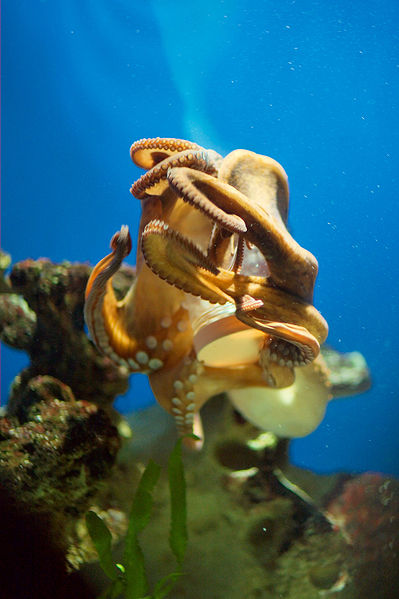 The female two-spotted octopus, about 30cm long, swam to the top of her tank and using her dextrous tentacles, unscrewed the water valve on her tank, releasing at least 200 gallons of seawater that gushed out into the aquarium causing havoc. The wily escapologist survived the ordeal but didn't quite manage break out of her tank.
The female two-spotted octopus, about 30cm long, swam to the top of her tank and using her dextrous tentacles, unscrewed the water valve on her tank, releasing at least 200 gallons of seawater that gushed out into the aquarium causing havoc. The wily escapologist survived the ordeal but didn't quite manage break out of her tank.
Octopuses are well known for their curiosity, nimble tentacles and immense strength. Biologists are still not sure just how intelligent octopuses are - and we don't know for sure whether this octopus was deliberately fiddling with the tank tap knowing what would happen - but they certainly seem to some of the brainiest invertebrates there are. They can learn behaviours like opening jars full of food and leap into neighbouring aquarium tanks in the search for food.
Perhaps the most brilliant animal in the world (in Helen's opinion anyway) is the Mimic Octopus that lives in Indonesia and spends its life doing amazing impersonations of lots of other animals like sea snakes, flat fish and lion fish.
Octopuses may even have a sense of humour. There's a story of an octopus that when it was given a slightly off shrimp to eat, stuffed it into a drain while keeping eye contact with the aquarium keeper, as if to say "I'm not eating that!"
Press Release from Santa Monica Pier Aquarium:
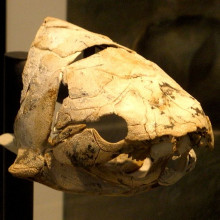
10:21 - First Fish Sex
First Fish Sex
Nicola Phillips and John Long
Nicky - Geologist John Long and his team have discovered how ancient vertebrates have sex and even how their penis functioned. This research, combined with early finds suggests that vertebrates separated into males and females in primitive fish almost four hundred million years ago. Scientists have known ancient fish had sex since their discovery of a primitive mother fish with a fossilised embryo inside it in the Gogo region 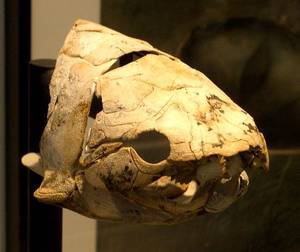 of Western Australia last year. The mother fish, a species called ptyctodon is from a group of extinct fish called placoderms. Since then scientists have pieced together fossil records of another species of placoderms called arthrodires and revealed they too contained embryos. These fossilised embryos are the oldest records of live birth in vertebrates. Because live birth can't occur without sex. Scientists knew that primitive fish were doing the deed but how some of them were doing hit has remained a mystery until now. John Long, from the Museum of Victoria:
of Western Australia last year. The mother fish, a species called ptyctodon is from a group of extinct fish called placoderms. Since then scientists have pieced together fossil records of another species of placoderms called arthrodires and revealed they too contained embryos. These fossilised embryos are the oldest records of live birth in vertebrates. Because live birth can't occur without sex. Scientists knew that primitive fish were doing the deed but how some of them were doing hit has remained a mystery until now. John Long, from the Museum of Victoria:
John - Now looking at more of this amazing fossil fish material from the Gogo fossil sites in Australia we've found that the biggest group of these armoured fish placoderms - the biggest group, the arthrodires - also have embryos inside them and they were also fertilising by males copulating with the females. This is something that we would not have expected. When you look at the group that the mother fish belongs to, the ptyctadons, they actually show sexual dimorphism. The males have claspers and the females don't. Claspers are what we see in sharks and rays today, how they copulate. The arthrodires, on the other hand, their pelvic fins up and till now have been always depicted as very simple structures just like simple fins. It may just go right back and look again, and look hard at these fossils to see if anything had been overlooked. We found it. 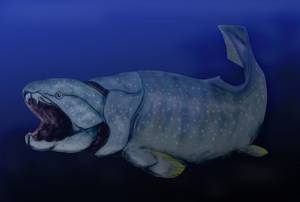 It was another fantastic eureka moment when you make a big discovery that for a hundred years has been completely overlooked. We found that these pelvic fins in these arthrodires had an extra articulation and that articulation meant that had a long lobe attached to the fin that was directed behind the fish in a rearward direction. That looks exactly like the claspers in modern sharks. We found out not only that this major group were having internal fertilisation but we found out how they were doing it. We believe that this shows the origin of the beginning of sexual dimorphism in vertebrates.
It was another fantastic eureka moment when you make a big discovery that for a hundred years has been completely overlooked. We found that these pelvic fins in these arthrodires had an extra articulation and that articulation meant that had a long lobe attached to the fin that was directed behind the fish in a rearward direction. That looks exactly like the claspers in modern sharks. We found out not only that this major group were having internal fertilisation but we found out how they were doing it. We believe that this shows the origin of the beginning of sexual dimorphism in vertebrates.
Ben - So structures found on fossilised fish can tell us a great deal about the evolution of sexual dimorphism. That's different characteristics for males and females and the more we understand about these ancient animals the better we understand our own evolutionary history. That was John Long from Museum Victoria.
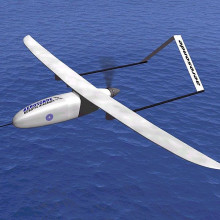
13:50 - Self-flying planes and Water Batteries
Self-flying planes and Water Batteries
Kelvin Kemm
Kelvin - Yeah that's right, it's a UAV which is an Unmanned Aerial Vehicle. The total weight of this thing is 30Kg, and the interesting thing is it's just recently done it's first autonomous flight. That means it's run totally on autopilot. Now South Africa, in fact, has many years of experience of designing these types of vehicles that have been driven by joystick, somebody sitting in a vehicle and flying the aircraft something like a great big video game. But this is the first time one has run entirely on autopilot. This one, by the way, is called E-Juba; E for electronic, as in email, and Juba meaning 'big bird'.
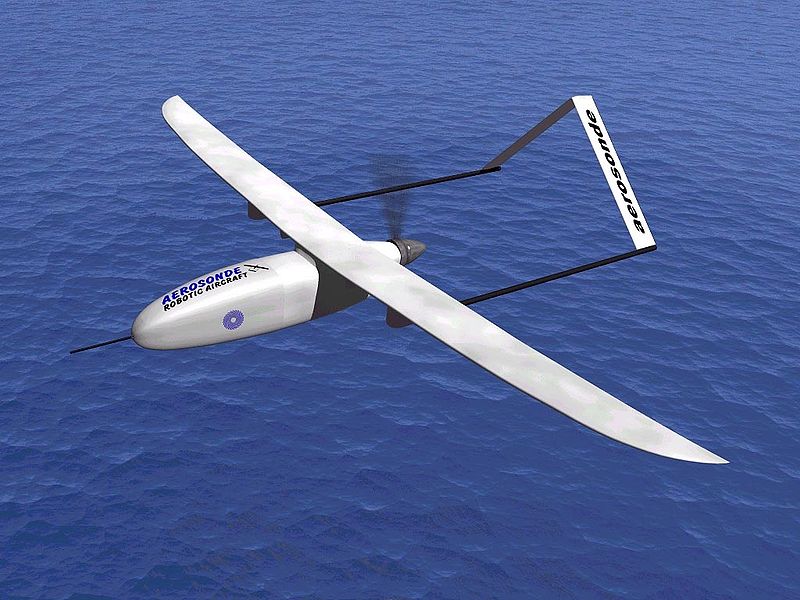 Meera - So how does this actually work on autopilot?
Meera - So how does this actually work on autopilot?
Kelvin - Well you can actually take off with the conventional joystick way, fly it along and then have programmed into it certain GPS points or certain flying patterns, instruct it to go over to autopilot which it then does by computer. It can fly from one GPS point to another GPS point, or it can fly a particular pattern. What it means is that it can fly far away from the controller, it's only limited by the amount of fuel you're carrying, for example. Interestingly enough, the type of thing they have in mind is to o and fetch blood samples from clinics that are far out in rural areas. Another interesting thing about this is if they keep the total mass below 30Kg, then by law, this is classified as a model aircraft and that means it's much easier legally to manoeuvre the aircraft around and to land in certain places and so on. If it goes above 30Kg it falls into a different legal bracket and then there's more stringent requirements on it flying over built up areas or landing and so on. Now it's very easy for these people to launch, all they need is like a rubber band type of launcher.
Meera - So does it not need a runway as such?
Kelvin - It can use a runway, but where you don't have a runway a reasonably ordinary catapult type thing can be provided, so all has got to be done is it's got to be shot into the air in some degree and then it will power itself and off it glides. It's then programmed to return to a particular hospital with this blood sample.
Meera - What about landing?
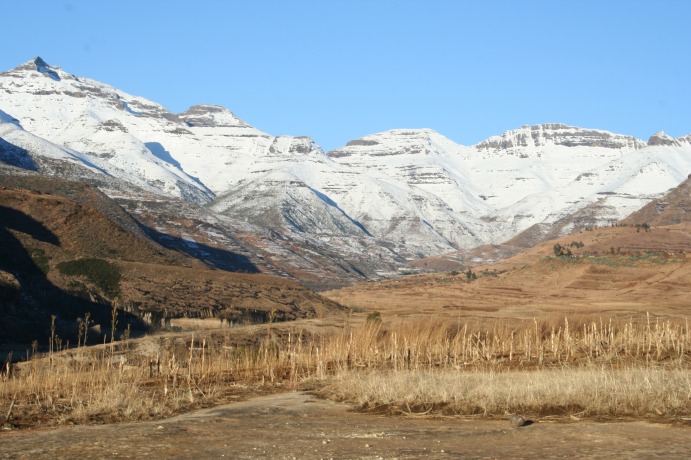 Kelvin - It lands on a runway if there's a runway there, but it can also land into something like a catch net. The aircraft can be aimed into the net and at the last moment you cut the motor and so the thing essentially falls into the net. So if it does land in some very rocky area or some busy area where there's no possibility of a runway, then that doesn't prohibit it from being launched again with something like a blood sample on board and heading back.
Kelvin - It lands on a runway if there's a runway there, but it can also land into something like a catch net. The aircraft can be aimed into the net and at the last moment you cut the motor and so the thing essentially falls into the net. So if it does land in some very rocky area or some busy area where there's no possibility of a runway, then that doesn't prohibit it from being launched again with something like a blood sample on board and heading back.
Meera - Now what would happen if something were to get in the way of it's flight path? Would it be able to deal with such a situation?
Kelvin - You obviously can build radars into it and so on to make it avoid such things, obviously every bit of fancy technology you add, adds to the weight. The ones that have been built in the past, South Africa's built some very big ones that have got all sorts of monitors on them, they can watch the ground in infra-red and with real cameras and, in fact, in real time the operator sits in the back of the truck and can actually watch the ground and so on and so forth. But those are a lot bigger than this 30Kg size. So now they're in the situation where it's flying autonomously and they've got to now make decisions as to exactly what do they put on it to keep it under 30Kg. The aeroplane itself is about 20Kg, and that allows for a 10Kg payload.
Meera - Okay, well hopefully more of these aircraft can be put in use to try and get blood samples from rural areas throughout Africa. Now also at the moment there seems to be what is essentially a large battery being built in the Drakensburg mountains in South Africa.
Kelvin - That's right. There's a range of mountains, the Drakensburg mountains which are the 'dragon mountains' that run between the province of KwaZulu Natal, which is the coastal province, and the more inland province of the Free State. There's a dam being built of the top of the mountain range on the Free State side and another one being built at the bottom on the KwaZulu Natal side. The difference in height between these two dams in 470m, in other words nearly half a kilometre, and they're about 6Km apart. So what happens is, the KwaZulu Natal province has got a lot of water, but up on the top side, the Free State side there's much less water, it's a much drier province. 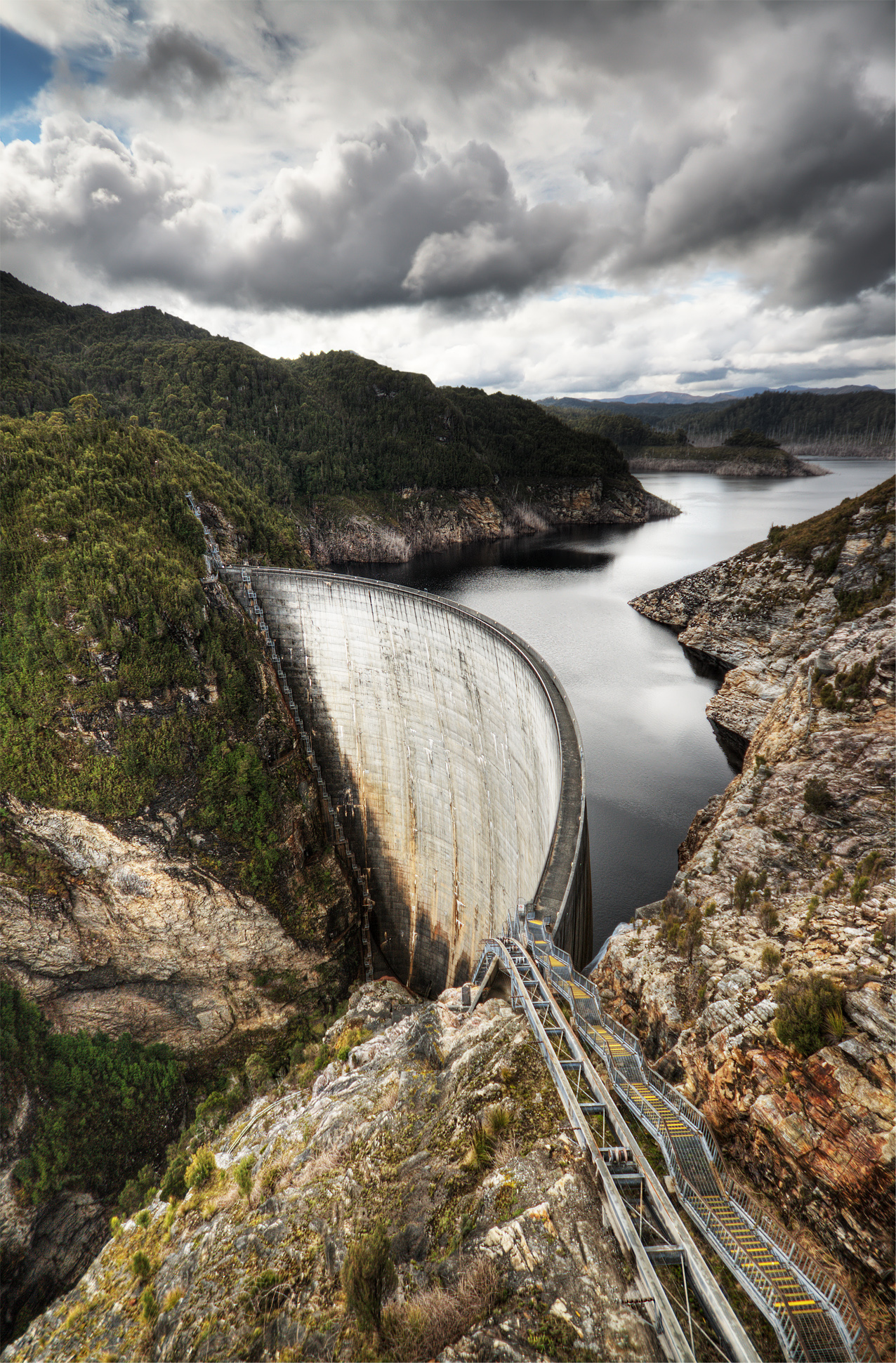 So during the course of the off-peak electricity periods, they pump water up from the KwaZulu side up to the dam on the Free State side. And there it sits with this potential energy 470m higher now than it was before. Then when peak load times come like breakfast time and dinner time, they then let the water run back through the pumps, and the pumps go in reverse and turn into turbines and produce power of 1330MW, which is substantial. Now they don't let all the water run back because part of the purpose is to supply water up into the Free State. Some of the water stays up there and then gets reticulated off as agricultural supply and household water and so on. When there's a demand for electricity that might suddenly occur, say, outside peak hours, it's a reasonably simple thing to do to stop the whole system pumping and then run it back down hill again into generator mode.
So during the course of the off-peak electricity periods, they pump water up from the KwaZulu side up to the dam on the Free State side. And there it sits with this potential energy 470m higher now than it was before. Then when peak load times come like breakfast time and dinner time, they then let the water run back through the pumps, and the pumps go in reverse and turn into turbines and produce power of 1330MW, which is substantial. Now they don't let all the water run back because part of the purpose is to supply water up into the Free State. Some of the water stays up there and then gets reticulated off as agricultural supply and household water and so on. When there's a demand for electricity that might suddenly occur, say, outside peak hours, it's a reasonably simple thing to do to stop the whole system pumping and then run it back down hill again into generator mode.
Meera - When is this likely to be completed and actually in use?
Kelvin - The target for the first unit to come online is April of 2012.
Meera - You mentioned that it will hopefully generate about 1330MW of electricity, what kind of things could that provide power for?
Kelvin - A medium sized town uses about 150-200MW, so what it does is it adds the amount of a sizeable couple of towns into the grid when you need it.
Meera - So why was this idea developed?
Kelvin - Well, South Africa is running a bit tight on electricity at the moment, we actually made international news about a year ago when there were some rolling blackouts in the country. One of the problems that happens in every 24hour cycle is that there's a peak requirement at breakfast time and a peak requirement at dinner time. It's not a good idea to have a whole power station running only to supply an hour or so worth of peak at the beginning of the day and the end of the day. It's good to have something like this "water battery" that can be used only during a one or two hour period, and at the same time act as a water supply to a water-deprived province.
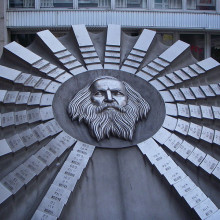
20:47 - This Week in Science History - Mendeleev's Periodic Table
This Week in Science History - Mendeleev's Periodic Table
Sarah Castor-Perry
This week in science history saw, in 1869, Dmitri Mendeleev presented his theory for the ordering of the elements into a periodic table to the Russian Chemical Society.
 In 1869 houses were still lit by gas lamps, the Suez canal opened, linking Europe and Asia by water, without having to navigate around Africa, and the first issue of the journal Nature was published.
In 1869 houses were still lit by gas lamps, the Suez canal opened, linking Europe and Asia by water, without having to navigate around Africa, and the first issue of the journal Nature was published.
The first to suggest that there were more elements in the world than the four of earth, air, fire and water, as suggested by the Greeks, was Robert Boyle in the mid 1600s - over 200 years before Mendeleev presented his table.
Several other scientists in the 19th Century had attempted groupings of elements, such as Johan Dobereiner, whose Law of Triads of 1829, suggested that the elements should be grouped in threes where the middle element would have properties that were the average of the elements either side. His example of chlorine-bromine-iodine was extended some years later to include fluorine, and other scientists realised properties extended over groups larger than three. As more elements were discovered, patterns in their properties began to emerge.
The French scientist De Chancourtois and the Englishman John Newlands both put forward more complex ideas on the ordering of elements in the early 1860s, but by 1869, 63 elements had been discovered, and Mendeleev chose to order them in a way noone had done before.
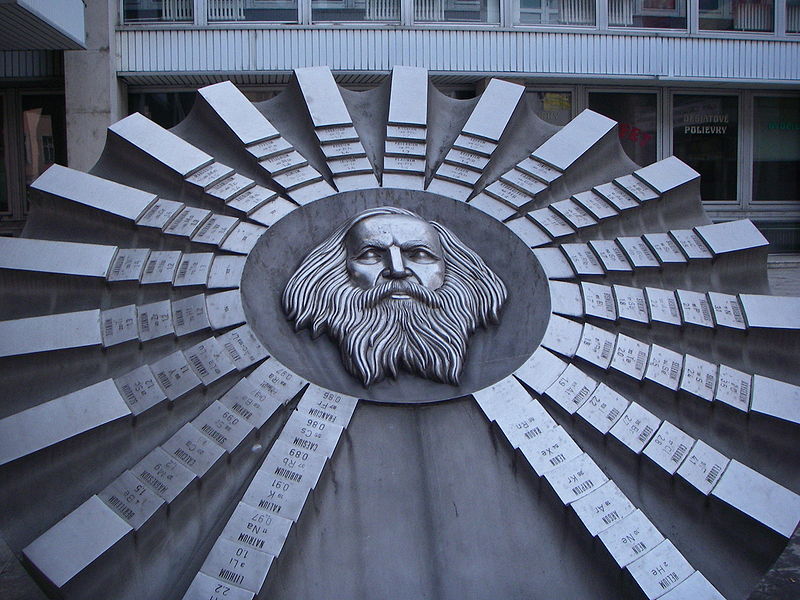 He wrote out a card for each element, with their name, atomic mass and chemical properties on, then laid them out like a game of solitaire, according to their chemical properties, rather than their mass number, which despite being pretty inaccurately calculated, was the conventional way to set them out at the time.
He wrote out a card for each element, with their name, atomic mass and chemical properties on, then laid them out like a game of solitaire, according to their chemical properties, rather than their mass number, which despite being pretty inaccurately calculated, was the conventional way to set them out at the time.
Mendeleev's Periodic Table showed the similarities and trends over much larger numbers of elements, both in vertical groups and horizontal periods in the table, rather than just in small groups such as in Doberiener's Law of Triads. He left spaces for elements he believed were yet to be discovered, and predicted their properties. He was proved right by the discovery of gallium, scandium and germanium later in the 1800s, and it is because of these predictions that Mendeleev is often considered more important in the discovery of the periodic table than the German scientist Lothar Meyer, who independently published a very similar table just months after Mendeleev.
In the 20th century, the table has been expanded and refined, to include elements that have been synthesised or are the result of nuclear decay rather than just those occurring naturally, but it still follows the same basic layout that Mendeleev predicted.
Knowing the order of the elements is not just a great teaching tool to understand how and why chemical properties change down a group or across a period, but also has had applications in industry, allowing people to predict how different compounds will respond when reacted.
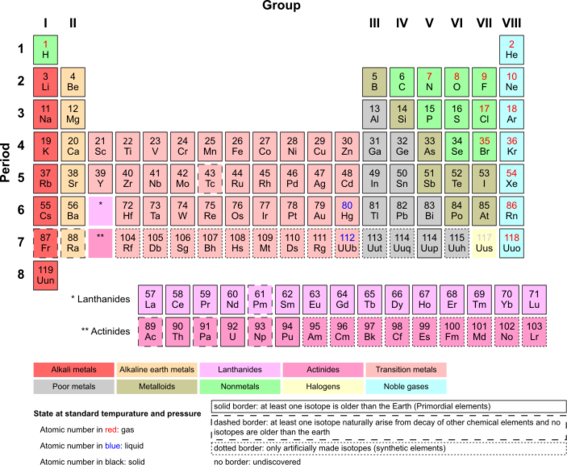
Related Content
- Previous Google Power
- Next Erbium: Chemistry in its element









Comments
Add a comment